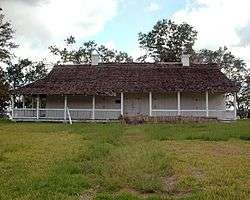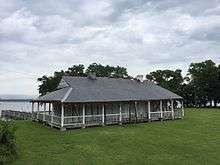Old Spanish Fort (Pascagoula, Mississippi)
|
Old Spanish Fort | |
 Main facade in 2006 | |
  | |
| Location |
200 Fort Street Pascagoula, Mississippi |
|---|---|
| Coordinates | 30°22′49″N 88°33′29″W / 30.38028°N 88.55806°WCoordinates: 30°22′49″N 88°33′29″W / 30.38028°N 88.55806°W |
| Built | circa 1757[1] |
| Architectural style | French Colonial |
| NRHP reference # | 71000452 |
| USMS # | 059-PAS-0001-NR-ML |
| Significant dates | |
| Added to NRHP | 1971 |
| Designated USMS | January 5, 1984[2] |
Old Spanish Fort, also known as Old French Fort and LaPointe-Krebs House, was built on the shore of Lake Catahoula (Krebs Lake) near what is now Pascagoula, Mississippi, by French Canadian Joseph Simon de la Pointe.[3] Construction of the house dates back to 1757, based on dendrochronology examination of structural timbers, making it the state's oldest surviving building, the state's only French Colonial structure still in existence, and the oldest scientifically-confirmed standing structure in the Mississippi River Valley.[1] The structure was added to the National Register of Historic Places in 1971 and was designated a Mississippi Landmark in 1984. The La Pointe - Krebs House is operated and maintained by the La Pointe - Krebs Foundation and serves as a museum.
Description
The "Old Spanish Fort" was not really a fort. Instead, it was a one-story, three-room structure that measured 37 feet (11.3 meters) in width and 62.25 feet (18.97 meters) in length.[4] Framing walls were 18 inches (45.7 centimeters) thick.[5] The building is constructed of longleaf pine framing, with walls of oyster-shell concrete in the oldest construction and with bousillage of clay and Spanish moss in the western and most recent addition. Dendrochronology dates the center tabby room to 1757 and the east tabby addition to 1762; and while no samples could be determined in the western bousillage addition, construction techniques and tool marks date the addition to 1820.[6]
Three sides of the structure were bounded by a galleries and porches, supported by square wooden posts that were joined by a timber framing system. The gable roof was covered with wooden shingles. Two fireplace chimneys were composed of stucco-covered brick. The original structure had one large room with two smaller rooms. Flooring was oyster-shell concrete covered in 1820 with boards at a height of 18 inches (45.7 centimeters).[4]
History
Between 1713 and 1717, Joseph Simon de la Pointe, an Admiral in Bienville's fleet, was granted land by the French Governor Antoine de la Mothe Cadillac to build a residence in Pascagoula.[7] The land was used predominantly as an indigo and wax myrtle plantation - the indigo to produce purple dye, the wax myrtle berries for candlemaking.
Hugo Ernestus Krebs, of German descent, acquired the property through marriage to de la Pointe's daughter, Marie Josephe. During Krebs' ownership, the property was maintained as a plantation with slaves and produced commodities such as rice and cotton.[8] Krebs also created a roller cotton gin more than two decades before the invention of Eli Whitney[9]
The name Old Spanish Fort was derived during Spanish control of the Mississippi Territory in the late 1700s, when the structure served as a fortified home of Don Enrique Ginarest, an officer in the Spanish Army, who married the granddaughter of Hugo Krebs.[10]
The structure was owned and occupied by descendants of Hugo Krebs until 1914.[4] At present day, the La Pointe - Krebs House and Property serve as a museum for the history of Pascagoula and Jackson County.

References
- 1 2 Magandy, Kate (May 31, 2016). "La Pointe-Krebs House in Pascagoula may be oldest in Deep South". Sun Herald. The McClatchy Company. Retrieved 2016-06-04.
- ↑ "Mississippi Landmarks". Retrieved 2014-04-16.
- ↑ Fort de la Point Retrieved 2012-09-13
- 1 2 3 National Register of Historic Places Nomination Form--Old Spanish Fort Retrieved 2012-09-08
- ↑ Old Spanish Fort Retrieved 2012-09-13
- ↑ Harley, Grant (2016). Dendrochronology Report at La Pointe - Krebs House. University of Southern Mississippi
- ↑ La Pointe - Krebs Museum Text, Pascagoula, Jackson County, MS
- ↑ Old French Fort, Pascagoula, Jackson County, MS Retrieved 2012-09-08
- ↑ Romans, Bernard (1775). A Concise Natural History of East and West Florida. ISBN 0817308768.
- ↑ Historical American Buildings Survey Old French Fort, Pascagoula, MS Retrieved 2012-09-08
External links

.jpg)
.svg.png)